Although Apple recently refreshed its 12-inch MacBook lineup with a faster SSD, new sixth-generation Skylake processors, and longer battery life, the Retina Macbook's USB Type-C input remains the notebook's single port, apart from a 3.5mm headphone jack. Similar to the launch of the first generation device in 2015, many fans lament not only the inability to use traditional USB 3.0 inputs without carrying around an adapter, but the safety issues present in a charging cable lacking Apple's trusty MagSafe technology.
To that end, at CES this year Griffin Technology introduced a third-party solution to the lack of a magnetic charging cable on the 12-inch MacBook, called the BreakSafe Magnetic USB-C Power Cable. The $39.99 kit comes with a six-foot cable and small metal dongle, which is about 3/4 of an inch long. Setup is simple: the cable is capped by a USB-C output, which users plug into Apple's packaged-in wall outlet brick. The dongle is plugged into the USB-C slot on the MacBook, so users can then charge the notebook using BreakSafe's quick-release magnetic connection.
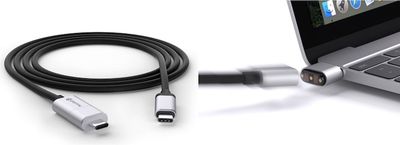
Similar to MagSafe, BreakSafe's purpose is largely to prevent the MacBook from tumbling down off of furniture -- or kicked along the floor -- when something snags the charging cable connected to a wall outlet and the computer itself. The messaging is focused on computers (and charging power only, as data and video are not supported), but the company does note that the idea transfers to USB-C supported smartphones and tablets as well.
Design
The dongle side of Griffin's new accessory hews closely in size to the Satechi Type-C USB Adapter I reviewed last year, but with the added bonus of a more ergonomic design. With its rounded edges, the BreakSafe comes out ahead of Satechi's adapter in feel, although Griffin is limiting users to one universal silver color that was slightly lighter than my Space Gray MacBook. Users with a Gold, or the new Rose Gold, color option might be bothered more by the dongle's clashing color so close to their preferred MacBook colorway.
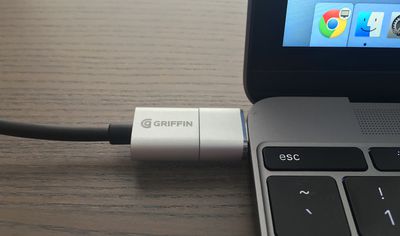
The dongle has a mark on the top side to remind users which side goes up when plugging it into the MacBook, although USB-C does allow reversible inputs so it doesn't much matter (a small Griffin logo resides on the opposite side). That gray line does have to line up with a similar engraving on the charging cable; otherwise the BreakSafe's reverse polarity pushes the two magnetic ends apart and fails to induce a charge to the MacBook.
That's the first minor issue -- of only a few -- with Griffin's MagSafe alternative. Apple's proprietary technology allows users to plug their MagSafe cables into their notebooks in either orientation; even the later-generation L-shaped MagSafe could be attached in reverse, albeit with the power cable blocking a few USB ports.
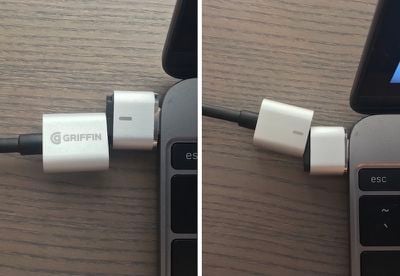
BreakSafe doesn't provide such a feature and as such isn't as slickly easy to use as the first-party alternative. Griffin informed me that the major reason behind its decision to not make BreakSafe reversible was its attempt to keep the connector as small as possible, while still managing to provide magnetic attraction and charge to the MacBook.
The company described the small markings on the cable and dongle, and the reverse magnetic push users receive when aligned incorrectly, as integrated "safety features" of BreakSafe, helping accustom users to regularly aligning the cable and connector. The system is a step above needing to look or feel for the MacBook's USB-C port to connect the cable, but it's also a step below Apple's seamlessly reversible MagSafe function.
Daily Use
Griffin's rough-and-tumble cable design, which is guaranteed for life by the company, helps make up in areas where the accessory lacks. I've only been using BreakSafe for a week so I can't refer to its long-term durability, but in direct comparison to Apple's, the third-party cable is far thicker and more resilient to annoying coiling prevalent in Apple's thin white cable. It is slightly shorter at 6ft (1.8m), compared to Apple's 6.5ft (2m) cable.
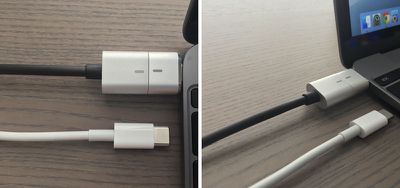
Powered off of Apple's 29-watt USB-C Power Adapter that's included with every 12-inch MacBook, Griffin's 60-watt BreakSafe cable has shown reliably fast charging speeds when the MacBook is both close to dying, and just in need of a quick top-off. I ran a charging speed test over the weekend to compare it with Apple's and, expectedly, the two came in around the same time. BreakSafe fueled the MacBook from 35 percent to 100 percent in 1 hour and 27 minutes, while Apple's included USB-C cable completed the same battery test in 1 hour and 25 minutes.
What will be the deciding factor on Griffin's BreakSafe cable for many users is the introduction of another minuscule accessory (12.8mm long to be exact) that needs to be kept track of to be able to fully use its features. The dongle is small in form factor, but recognizably thicker in comparison with Apple's charger. When inserted into the MacBook, there's a a definite protrusion and even a slight amount of wiggle when touching the BreakSafe plug, which gave me some hesitation about keeping it attached when not in use.
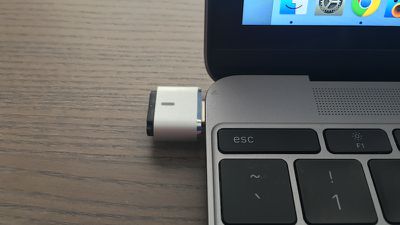
Of course, removing the dongle when not in use would negate the entire reason for its existence, since every time you plug it back in you return to the original problem of correctly aligning a USB-C plug into the MacBook. To replicate a MagSafe-like experience on the 12-inch Retina MacBook, you would have to keep the BreakSafe dongle plugged into your MacBook at all times.
Such a decision comes down to personal preference, but as someone who's by-and-large gotten accustomed to daily USB-C charging, the idea of adding yet another Type-C accessory to a growing list of necessities needed for my year-old 12-inch MacBook, especially when traveling, just isn't worth the hassle.
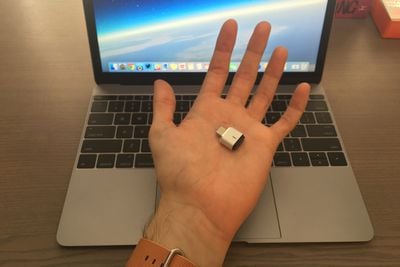
Griffin's alternative also feels tangibly less magnetic than MagSafe. That means BreakSafe will successfully disengage when users place enough pressure on the cable, but I also found it to disconnect unintentionally without me even knowing. In the first test, I left the cable plugged in and returned intermittently to check my MacBook's charge level, and discovered twice that the two correctly aligned magnetic ends were touching, but not fully connected.
This might be an individual issue (my MacBook was placed on a standing desk which was raised and lowered a few times during the test), but the thickness of BreakSafe's cable seems to generate one negative in this regard, occasionally pulling on the slightly-weaker-than-MagSafe connection and disrupting charge to the MacBook.
Bottom Line
Someone who is just joining the USB-C world that Apple is forging with the Retina MacBooks could find Griffin's cable a decent alternative to using Apple's included charging cable, and users who routinely use their machines in environments where the charging cord is likely to be pulled or tripped over will appreciate the peace of mind BreakSafe brings.
It's a quality accessory in any capacity, and running for $39.99, BreakSafe is also largely competitive with Apple's $29.99 USB Type-C cable. It's not without some drawbacks, the biggest one being its lack of magnetically reversible charging, so if you've already gotten used to the USB-C setup it may not be worth the effort and expense to switch back to a magnetic interface.
How To Buy
Griffin is currently selling the BreakSafe Magnetic USB-C Power Cable from its website for $39.99.





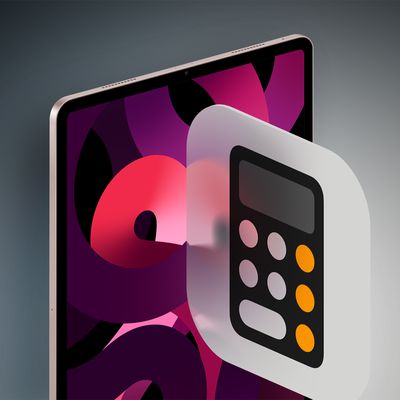













Top Rated Comments